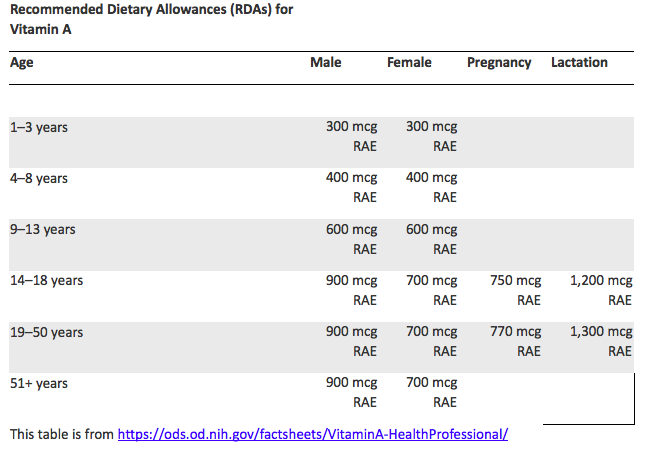How Much Vitamin A Do I Need?
The Recommended Dietary Allowance (RDA) for vitamin A is in retinol activity equivalents (RAE) to account for the different bioactivities of retinol and provitamin A carotenoids, all of which are converted by the body into retinol. The RDA is set to provide the average daily amount to meet the nutrient requirements of nearly all (97%–98%) healthy people. What are the risks of too much Vitamin A?Vitamin A is stored in the liver, and because it is fat soluble, excessive amounts can build up and lead to toxicity. Chronic high intakes of Vitamin A from supplements or food can lead to increased intracranial pressure, dizziness, nausea, headaches, skin irritation, pain in joints and bones, coma, and even death. The Tolerable Upper Intake Level (UL) applies to the upper daily amount of Vitamin A from foods and supplements associated with an increased risk of liver toxicity. Unless your physician recommends otherwise, stay under the UL for the best health.
What are the risks of too much Vitamin A?Vitamin A is stored in the liver, and because it is fat soluble, excessive amounts can build up and lead to toxicity. Chronic high intakes of Vitamin A from supplements or food can lead to increased intracranial pressure, dizziness, nausea, headaches, skin irritation, pain in joints and bones, coma, and even death. The Tolerable Upper Intake Level (UL) applies to the upper daily amount of Vitamin A from foods and supplements associated with an increased risk of liver toxicity. Unless your physician recommends otherwise, stay under the UL for the best health. Find out more about Vitamin A!
Find out more about Vitamin A!
By Lynn Grieger, RDN, CDCES, CPT, CHWCReferences:
- National Institutes of Health, Office of Dietary Supplements, Vitamin A Fact Sheet for Health Professionals. https://ods.od.nih.gov/factsheets/VitaminA-HealthProfessional/ updated 2-14-20, accessed 5-22-20
- Zhiyi Huang, Yu Liu, et al. Role of Vitamin A in the Immune System. J Clin Med. 2018 Sep; 7(9): 258.
- Ross AC. Vitamin A and retinoic acid in T cell-related immunity. Am J Clin Nutr. 2012;96(5):1166S?72S. doi:10.3945/ajcn.112.034637
- J.A. Hall et al. Essential role for retinoic acid in the promotion of CD4+ T cell effector responses via retinoic acid receptor alpha. Immunity. 2011 Mar 25; 34(3): 435–447.
- Milk Facts. http://www.milkfacts.info/Milk%20Composition/VitaminsMinerals.htm accessed 5-24-20.
